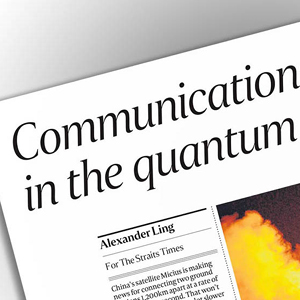Highlights
Researchers achieve record speed for quantum secure communication
Quantum key distribution (QKD) is a technique to exchange encryption keys for secure communication - but current QKD systems suffer from low secret key rates. CQT Fellow Charles Lim and his collaborators have demonstrated a QKD protocol that achieves a record speed of 26.2 megabits per second over the equivalent of 20km of optical fibre.
Current bit rates could be used to protect an organisation's most sensitive data. But if organisations move to use quantum encryption technology for all their data traffic, or if consumers want this security too, demand could soon outstrip supply.
"Poor secret key rates arising from current QKD implementations have been a major bottleneck affecting the use of quantum secure communication on a wider scale. For practical applications, such systems need to be able to generate secret key rates in the order of megabits per second to meet today’s digital communication requirements,” says Charles, who is also an Assistant Professor in the NUS Department of Electrical and Computer Engineering.
The trick to the team's success was using higher-dimensional quantum bits to distribute secret keys. They reported their findings in a paper published 24 November in Science Advances.
Becoming quantum-safe
Recent progress in quantum computing has been driving interest in QKD as a 'quantum-safe' encryption solution. If large quantum computers are built, they will be able to break today's most prevalent encryption techniques by solving the mathematical problems these schemes are based on. Moving to new forms of encryption now will protect data from being decrypted retrospectively.
Globally, there are already several companies selling QKD systems using “prepare and measure” protocols. The idea is that two parties who need to communicate in private exchange single particles of light: one party prepares randomly encoded photons, and the other measures them to derive the secret key. Typically, the key is based on measurements of the photons' polarisation.
Locally, CQT is working with Singapore’s leading telecommunication company, Singtel, to demonstrate entanglement-based QKD systems on the company's fibre network. This scheme would allow the telco to act as a third-party supplier of “quantum ready” photons for QKD or other quantum application to its customers.
Faster prepare-and-measure protocols
Charles, working with scientists from Duke University, Oak Ridge National Laboratory and Ohio State University, all in the United States, achieved the speed record with a new prepare-and-measure scheme. Instead of using photons' polarisation states - a two-dimensional state that delivers only one key bit per photon - the team define a four-dimensional 'time-binned' state that delivers two key bits per photon.
In this approach, secret bits are encoded in the arrival time of single photons, while the complementary phase states — for measuring information leakages — are encoded in the relative phases of the time states. This encoding technique, in principle, could allow one to pack arbitrarily many bits into a single photon and generate extremely high secret key rates for QKD. However, implementing such high-dimensional systems is technically challenging and tools for quantifying the practical security of high-dimensional QKD are limited.
To overcome these problems for their QKD system, the researchers used a novel combination of security proof techniques developed by Charles and an interferometry technique from his experimental colleagues. The security analysis shows that the protocol is robust against coherent attacks, finite-size effects, and a broad class of experimental imperfections. The system itself was built from off-the-shelf components.
“Our newly developed theoretical and experimental techniques have resolved some of the major challenges for high-dimensional QKD systems based on time-bin encoding, and could potentially be used for image and video encryption, as well as data transfer involving large encrypted databases,” says Charles.
The team's results were covered by media including TechExplorist, The Register and Phys.org.
Charles, who joined the Centre as a CQT Fellow this year, is collaborating with CQT's quantum satellite researchers on security analysis for QKD space technology. He has maintained close ties with CQT since he was an NUS undergraduate, completing his final year project with Valerio Scarani at the Centre in 2010.
Learn more
Related Stories
 | Going covert: a security step above encryption December 21 2016 |
 | Communications privacy in the quantum era June 18 2017 |
 | Bringing quantum tech to new NUS-Singtel corporate lab October 24 2016 |






